Staying Active to cope up with Blood Cancer
Our health is our responsibility, and to live a healthy life, it is important to take care of ourself, especially for the sake of the loved ones. The best way to fight against the cancer demon is by exercising regularly and staying physically active. This effort will help you heal and lead a normal life as a cancer survivor. Exercising is safe and possible during cancer treatment. However, getting active and doing your exercise after blood cancer detection can be a little difficult, but there are many simple and easy exercises, which you can do without much difficulty. Exercising or doing physical activities throughout the treatment is known to have many beneficial effects. It will help you live longer and lead a more active life. Higher levels of physical activity can also reduce the risk of cancer recurrence.
Benefits of exercising
- Helps to maintain an ideal body weight
- Keeps the heart healthy
- Improves the strength of bones and muscles
- Reduces anxiety (nervousness) and depression due to cancer diagnosis and treatment
- Improves the cancer-related pain, nausea, and tiredness (fatigue)
- Improves the self-esteem and ability to keep social contacts
- Makes one less dependent on others to carry out daily day-to-day activities
- Improves the blood flow to the legs, thereby preventing the risk of blood clots
- Improves balance, thereby preventing falls and fracturing the bones
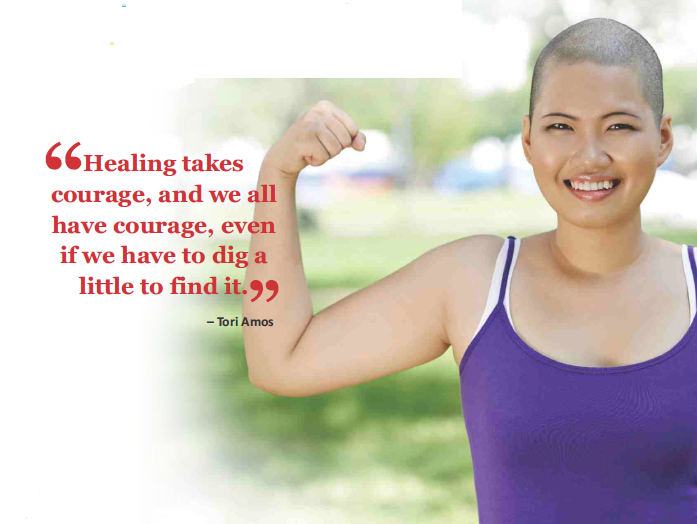
Thus, it is important for you to do some physical activities and exercises to improve your health. You can start with some gentle and low-intensity activities, and then, gradually increase your activities as you become stronger and fitter. You can exercise for about 30–60 min at least 5 days in a week.
Helpful tips for exercising
- Focus on having fun while you exercise.
- You can do something different like yoga.
- You can take support of friends, family, or coworkers to exercise with you.
- You can record your exercise progress on charts.
- Identify and reward your accomplished achievements.
Precautions to be taken while exercising
- Do not exercise if your red blood cell count is low (ie, if you have anemia).
- Do not exercise if the levels of minerals, such as sodium and potassium, are not normal in your body; this can happen due to vomiting or diarrhea.
- Do not exercise during unrelieved pain or nausea/vomiting.
Exercises to help you stay physically active
Here are some easy, light, and simple indoor exercises, which you can perform as you lie or sit on your bed or while you sit in a chair. These exercises help to improve the blood circulation and prevent your joints from getting stiff. They also help to maintain and improve your muscle strength.
You can start by doing each exercise five times (except exercise 1). You can gradually increase it to ten times as your strength increases.
While on the bed
1. Ankle exercises
a. Pull your feet up and down quickly (ten times each leg).
b. Rotate the ankles in clockwise and anticlockwise directions (ten times each leg).
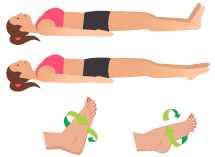
While on the bed
2. Knee flexion/extension
Bend and straighten your knee (five times each leg).
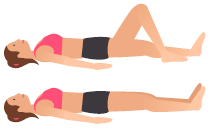
While on the bed
3. Abduction/Adduction
Move your leg out to the side as far as you can, and then bring it back to the mid position (five times each leg).
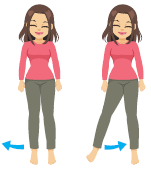
While on the bed
4. Straight leg raise
Keep your leg straight by pushing the knee down into the bed, pull your foot and toes up, and lift the leg approximately 20 cm (8 inches) off the bed (five times each leg).
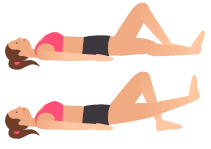
While standing
5. Arm exercises
Lift up both the arms above your head, and then out in front of you (five times).

While sitting on a chair
6. Inner range quadriceps
Move your toes up, tighten your thigh muscles, and straighten your knee. Hold for a count of three, and then slowly relax your leg (five times each leg).
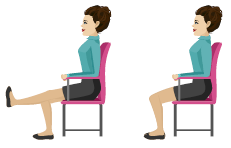
While sitting on a chair
7. Sit to stand
Sit on a chair with your arms crossed close to your chest, stand up, and then sit down slowly (five times).
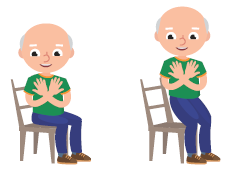
Breathing exercise
8. Deep breathing exercises
Straighten your back and relax your shoulders. Keep the hands on the sides of your chest, breathe in through your nose slowly, expanding your chest and feeling the movement under your hand, hold for 3 seconds, and then breathe out (practice taking three deep breaths after every 30 min).
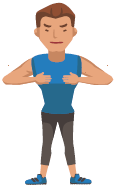
Yoga
In addition to the above exercises, the practice of yoga postures (asanas), breathing, and meditation techniques are also a good choice.
Benefits of yoga
- Has a “Mood Boosting” effect and makes one feel good
- Calms the mind
- Enhances and boosts the emotional and physical well-being
- Improves the quality of life and brings about the desired peace of mind.
- Improves fitness and reduces pain, tiredness, stress, fear, anxiety, and depression
- Strengthens immunity (resistance to infection) and reduces inflammation (swelling)
- Helps to cope with the treatment in a better way
Cancer-related fatigue
It is very common for you to feel tired or feel as if you have no energy. This feeling is natural, especially when your body as well as brain feels tired. However, this fatigue is temporary and can be reduced by regular exercising. Exercising will help to improve your fatigue and tiredness and help you carry out your normal daily activities without much problems.
Tips to reduce cancer-related fatigue
- Set a daily routine that will help you stay active.
- Perform a light-to-moderate intensity exercise for about 10 min regularly, if you feel very tired or don’t feel like exercising.
- Go out in fresh air.
- Eat a balanced diet rich in proteins, such as meat, milk, eggs, and legumes such as peas or beans
- Drink at least 8–10 glasses of water daily.
- Try to keep pain, nausea, or depression under control.
- Keep things you need or use often within easy reach to save your energy.
- Enjoy your hobbies, and do activities that make you happy.












